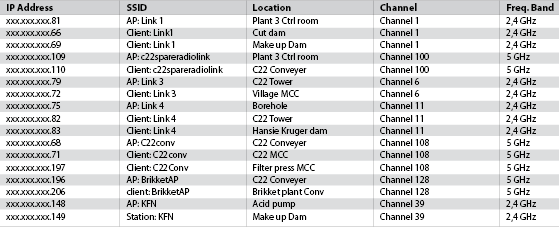
Optimum Coal – Koornfontein, is a coal processing plant in Mpumalanga situated between Emalahleni (Witbank) and Hendrina. The plant, spread over a wide geographic area as shown in the satellite photograph, needed to draw information from the remote pump stations located at the dams and bring it back to the central control room for processing. The distances involved (over 2 km) ruled out the possibility of a wired solution, which meant that a wireless telemetry network would be required. It was at this point that Allpronix was brought in to assist with the design architecture.

“What was initially required was to bring the water levels back to the central scada system for monitoring and control purposes,” says Allpronix field and instrument engineer, Jurie Weidemann. “But subsequently we found that there were other areas of the plant that could benefit from the wireless telemetry system we had in mind.
“There are currently a total of 8 main wireless links that are being used for plant monitoring, telemetry and PLC/scada diagnostics and troubleshooting. The network is a combination of 5 and 2,4 GHz components, the 5 GHz with its faster data rate is used as the backbone network to cut down on possible interference and the 2,4 GHz is used for the close proximity links. As the plant expands, more links will be added to the network with a total of 35 CPEs (customer premises equipment) expected to make up the final wireless network spread across the plant and surrounding pump stations.”
Equipment used in the network design so far includes:
* Airlive Outdoor wireless CPEs: 2,4 GHz – 802.11g compliant max 54 Mbit/s.
* Airlive Outdoor wireless CPEs: 5 GHz – 802.11a/n compliant with 1T1R technology max 150 Mbit/s.
* I/O over Ethernet: Acromag. Korenix JetNet 2005 – unmanaged 5-port switch.
The Airlive CPEs are powered using passive POE through 12 VDC POE injectors via the shielded CAT5 cable used to connect to the network through Allpronix supplied Korenix 2005, 5 port, as well as other unmanaged switches. The RJ45 connectors are wired as patch cables according to the T568B colour code as set out by the TIA/EIA-568 standard: http://en.wikipedia.org/wiki/TIA/EIA-568
Project progress: problems experienced, corrective action and fine tuning
In South Africa, there are 13 available channels for 2,4 GHz CPEs. Initially, the network was set up ad-hoc, with not much attention given to interference between channels or interference from power lines and other sources. The drawback using 2,4 GHz is that the frequency of the harmonics generated by heavy electrical machinery and power lines are often in this range and can therefore cause interference. Also, due to channel overlap, it is best practice to have five degrees of separation between the channels of neighbouring access points.

As shown in Figure 1, channels 1, 6 and 11 do not interfere with each other at all. Figure 2 shows how the channels and access points can be arranged to avoid interference when the concentration of access points is high.

“We encountered interference primarily on two of the wireless links, namely the link from ‘Plant 3 Control Room’ to ‘C22 Tower’ and the link from ‘C22 Conveyer’ to the ‘FilterPress’,” explains Weidemann. “These two links would work fine for intervals, but would then require a reboot to re-establish the network. The stability of these two links has subsequently been vastly improved by replacing the existing 2,4 GHz CPEs with Airlive’s AirMax5N-ESD, 5 GHz versions, while still keeping possible channel interference in mind. Each link is established by setting up one CPE as an access point and the other as a client. AirMax units are directional and the 16 dBi internal antenna provides the necessary transmitting power to establish reliable wireless communication on a stable 5 GHz frequency band.”
The table shows the current network layout.

Figure 3 shows the network topology of the current links as well as the ‘project in progress’ links. It also shows where there are PLCs and switches that connect all the wireless units to the main network.

“As is evident from the diagram, this project is a work in progress and as there is still plenty of plant expansion in the pipeline, the telemetry network will have to grow as required in order to meet the increased demand,” concludes Weidemann.
For more information contact Jurie Weidemann, Allpronix, +27 (0) 11 795 9500, [email protected], www.allpronix.com
| Tel: | +27 11 795 9500 |
| Email: | [email protected] |
| www: | www.allpronix.com |
| Articles: | More information and articles about Allpronix |

© Technews Publishing (Pty) Ltd | All Rights Reserved